On July 24th, MRL 4312 arrived in New Westminster BC and was used to power the MRL business train back to Montana. The unit had been forwarded from the Mid West to New Westminster, BC over the BNSF. Photo by Greg Shevchenko.




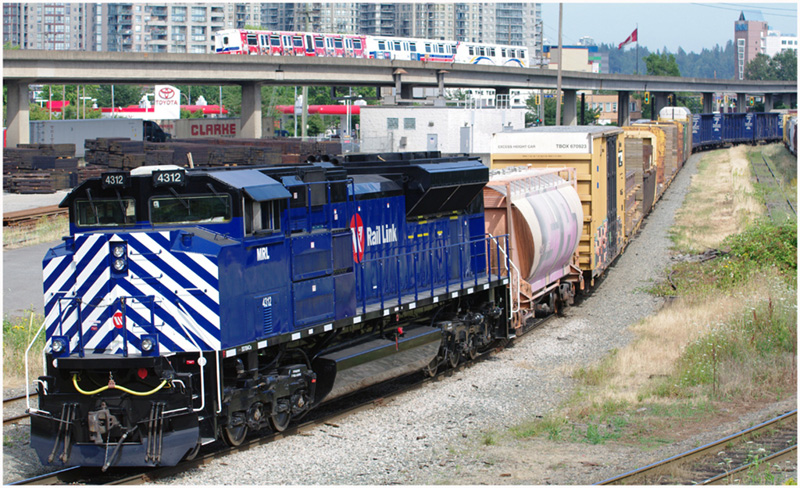
Kevin Dunk photographed N&FS GP9 4519 crossing bridge #7, over Beaver Creek Falls at Montrose, BC May 25th. The geep was leading an excursion for the Fruitvale’s “Beaver Valley May Days” event in 2013. The N&FS owns just two pieces of equipment; an engine and a coach. N&FS 4519, lettered IRRS from previous owners, is an EMD GP9 loco built in 1957 (ser#22867) and was built as Grand Trunk Western 919 and later renumbered GTW 4519. The coach numbered #2021 was built by Pullman Standard in 1963 and served on the Long Island RR as LIRR 2021 and nee as the LIRR MU Coach 2624. (Data courtesy of the Canadian Trackside Guide)
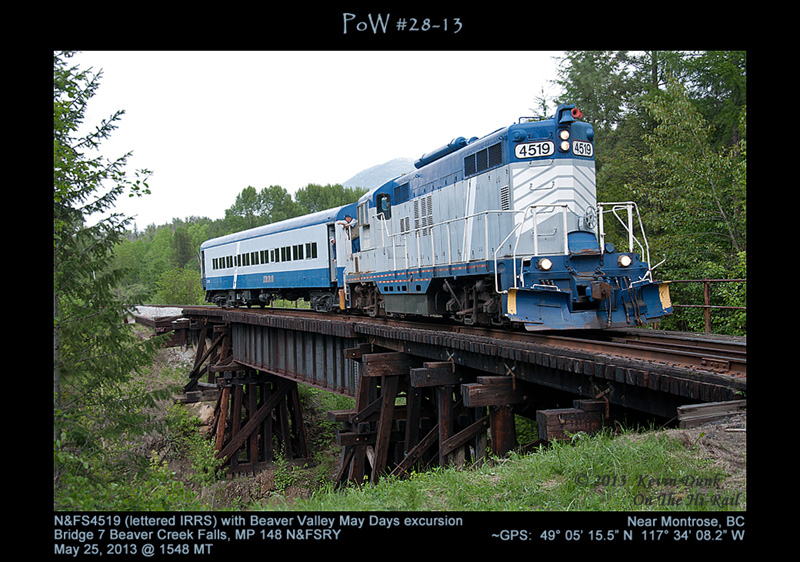
On July 14th, At New Westminster, BC Greg Shevchenko snagged the SRY train the “Langley Turn” with CP GP9u 1647 and blue painted CP GP9u 1609 both DIT and stripped of parts, enroute to ABC Metals in Langley for scrapping. Apparently that the blue-painted ex- CP 1609 was used for some movie shoots on Vancouver Island, for the Godzilla movie.
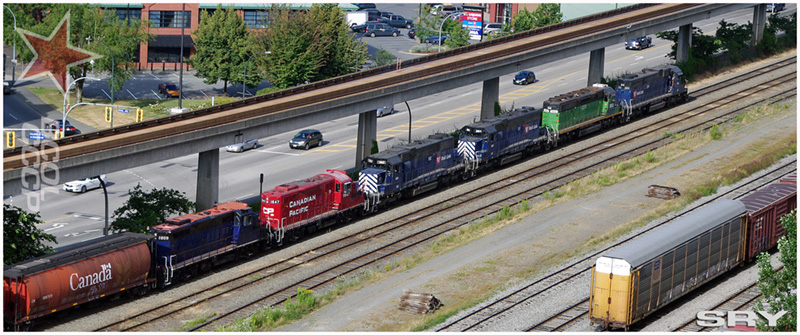
Cando Contracting GP9RM 7059 (in CN paint) was moved from SRY Shop in BC via CN to Winnipeg in July. The locomotive will be renumbered and repainted into Cando Contracting corporate livery and renumbered into the 4600-series.
Diesel Electric Services DESX GP10 8304 (ex-IC nee-Mid South Rail) has been leased to the Great Western Railway for service.
The Alco T-6 that has been stored on the SRY in New Westminster, BC was moved in early June from BC to Assiniboia, SK. It was originally Portland Terminal 46 and then NBTX 804 in North Vancouver. Devon Generous of the Southern Prairie Railway has purchased the Alco switcher and renumbered it SLSX 46 (Saturday Locomotive Services) for use on the Southern Prairie Railway out of Ogema SK. As Devon is an Alco buff, the unit will be returned to operation and restored as time permits. Another Alco saved from the Toyota supply line! Photo by Andy Cassidy.
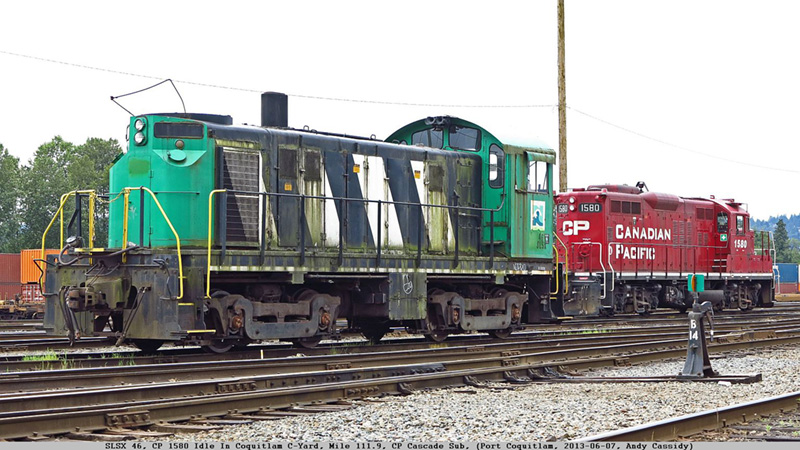
During the 1990’s ALSTOM had a contract to rebuild 40 CN SD40’s into BNSF SD40-2’s and were numbered 7300-7339, Later renumbered into the 6900 series, BNSF is now retiring the last of them. A grain company in Unity, SK had been using a 4-axle locomotive that proved insufficient to move the heavy loaded cars and has leased (ex-BNSF) DLCX 6961 and 6991. The pair were being delivered at press time. The DLCX pair were photographed sitting at the CN engine facility in Stevens Point, WI.
http://www.flickr.com/photos/38714716@N02/9348258806/
An oil industry located on the Alberta, border and served by the Saskatchewan-based Great Plains Railway, has received an SW1200 from the USA, and which has been renumbered to Locomotive Diesel Services LDSX 121.
Richardson International a grain company in Estavan, SK, has leased LTEX GP15-1 1450 from Larry’s Truck Electric.
On the Great Western Railway, the two GWR B-23-7’s are on the property with the 4064 in service with the corner windows added. The 4062 has an issue in the equipment blower and will get the corner windows added soon. The three MLW’s are in service as well, but GWR M420W 2002 in for top deck overhaul and 2004 will need an engine change-out. The ex-BNSF dash 8W’s are both in service.
Diesel Electric Servics (DESX) GP10 8308 (ex-IC nee-Mid South Rail) has been leased to the Great Western Railway for service.
CRLX 2101, a GE 80-Ton switcher arrived at CN's Walker Yard in Edmonton last fall and was in transit to the Alberta Railway Museum. However, the final leg of the move has been delayed ever since. On June 24th, Jesse Acorn caught her at the near diesel shop. Built in 1950 as Stelco #52 in Hamilton, ON, In 1985, the loco became Altasteel with no Number sold many years ago, and spent the end of her career working at Altasteel in Edmonton Alberta, until retired and was donated to the Alberta Railway Museum last year. Now she just needs to get there. Last year 44-ton switcher CN #4 arrived at the museum and was repainted back into its original CN colors. (Jesse Acorn Photo)
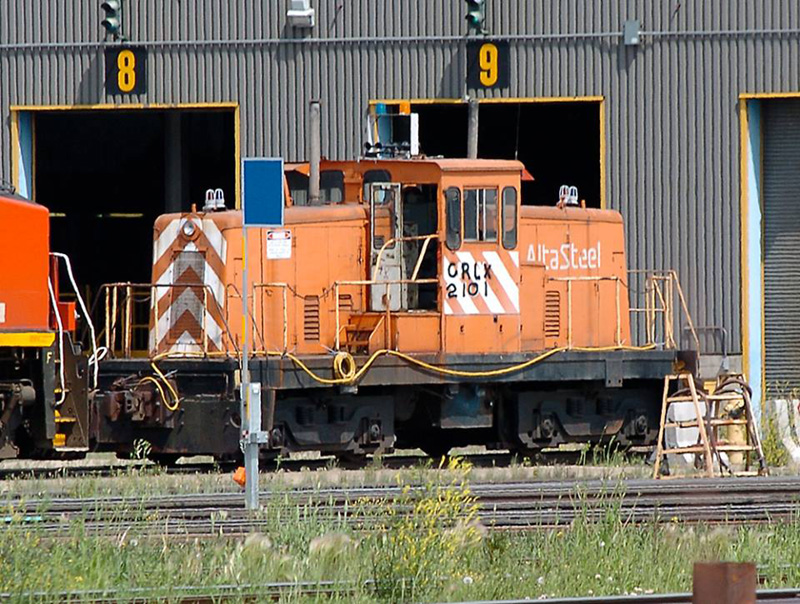
Cando Contracting GP9RM 7059 (in CN paint) was moved from SRY Shop in BC via CN to Winnipeg in July. The locomotive will be renumbered and repainted into Cando Contracting corporate livery and renumbered into the 4600-series.
Hudson Bay Railway (HBRY) has leased HLCX SD$0-2 7231 which was photographed at Symington Shop onon July 18th, by Mark Perry, before heading north.
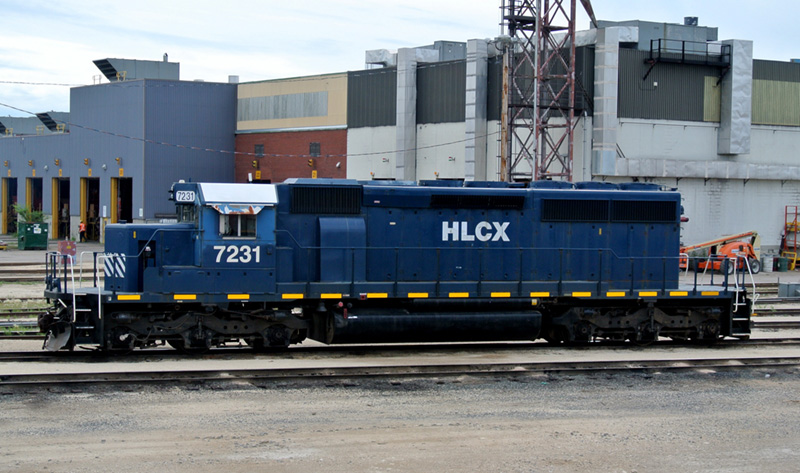
Plagued with mechanical issues since her arrival, RTEX 8153 had been leased to Hudson Bay Mining and Smelting, and is now being returned to the lessor Rail Trusts. While it is mostly in running order, HBM&S took back the parts they stripped from 8161 to keep it going.
Rocky Mountaineer Rail Tours has leased NREX 2903 and is seen here on CN trackage on the Rocky Mountaineer train while stopped in Jasper, Alberta on July 1st. (Sean Hennessey photo).
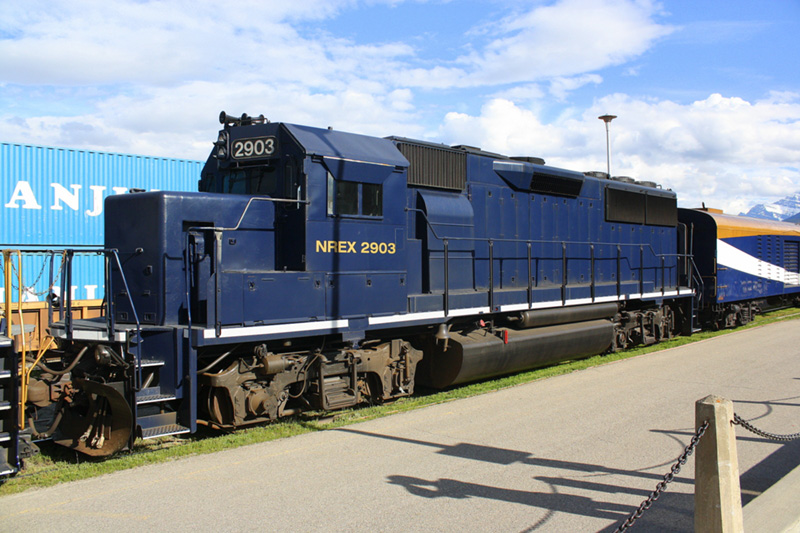
The Stewart South Railway got some more power in August. SSR 2237 and 2238 heading east towards the SSR August 1st. trailing SSR 1504 and 1505. They are apparently both ex EMDX units, possibly ex-CR 8027 & 8028, nee-PC 8027 & 8028.
The SSR 4255 (ex-Santa Fe) hasn’t been seen in quite a while but has come into and departed from Regina yesterday. The SSR 1010 (another one of the GE B23-7s) came into Regina yesterday but did not go back east. The CEFX 1509 (not lettered for the SSR) has also been running back and forth after a long absence but again did not go east this morning. I haven’t seen the SSR 1009 since late June. Anyone know if the 1009, 1010 and 1509 are gone from the SSR?
Photos by David Onodera
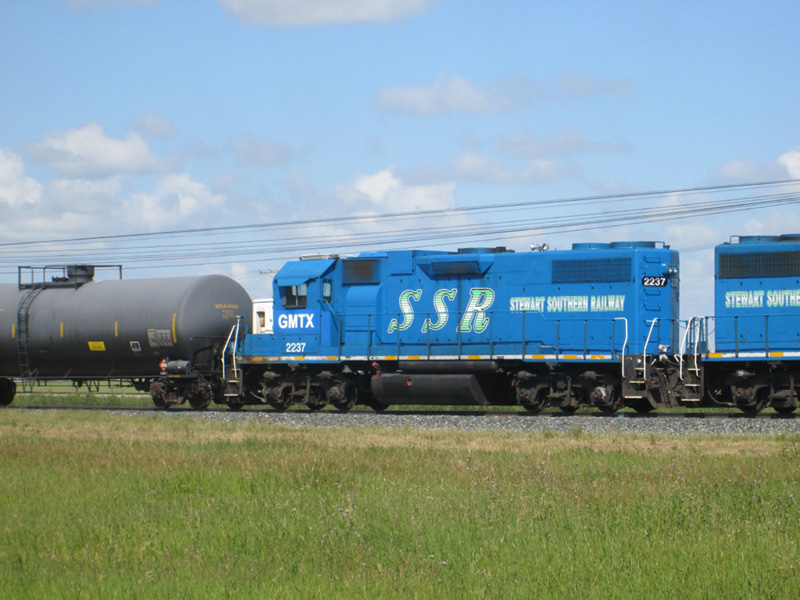
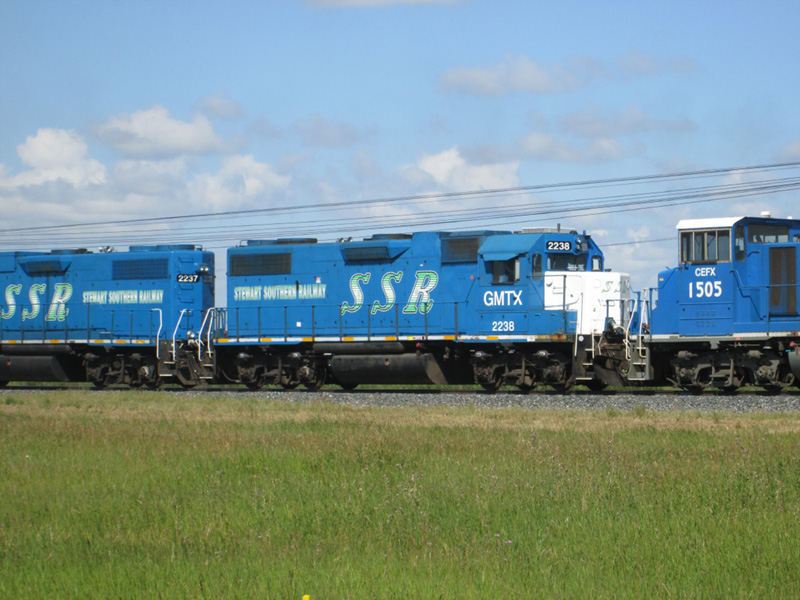
The CP Track Inspection Train once again tested all of Ontario Northland's mainline trackage in late May. Here we catch the special consist, this time being lead by CP (D&H) GP38-2 7309, undergoing a head end crew change at Cochrane before embarking for Hearst as the 4PM yard job utilizing GP9 1603 works alongside May 28th.
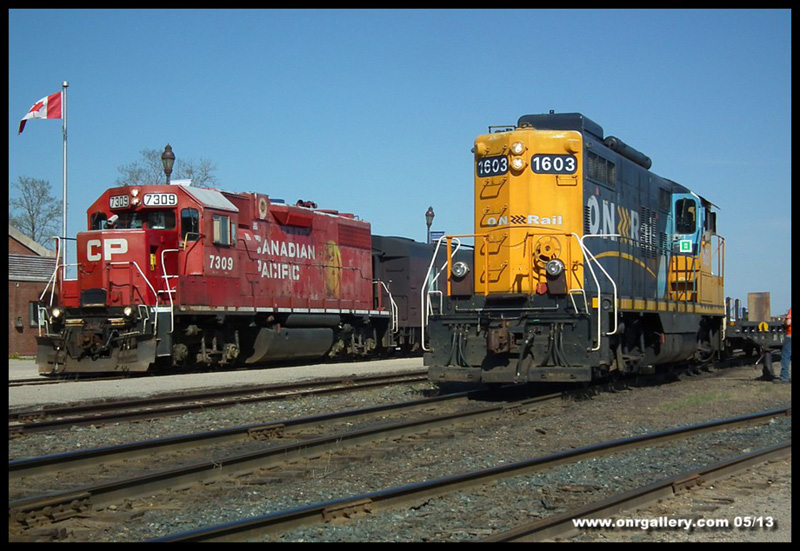
June 13th 2013 marked the final day of rail shipping from Agrium KPO (Kapuskasing Phosphate Operations). It seems like yesterday when the Agrium spur opened with great fanfare almost a decade ago. Unfortunately the time has come for Agrium to close the mine as the mine's supply of phosphate is no longer economically feasible to mine. This photo was captured back in 2012 as hoppers are loaded at the mine for shipment to Alberta (Mike Robin Photo).
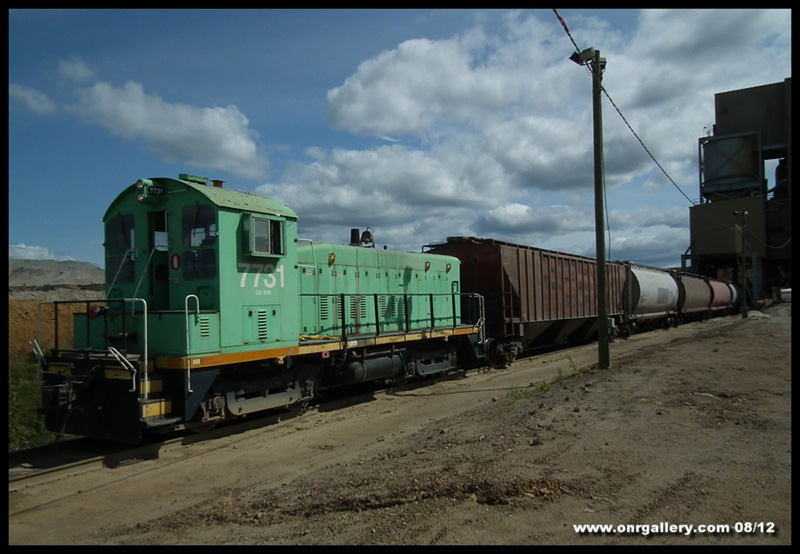
Ontario Northland Vignette:
ONR GP38-2 1809 complete with her “Polar Bear Express” placard and was snapped by Mike Robin working the 1400 Yard Job at Cochrane back in August 2003.
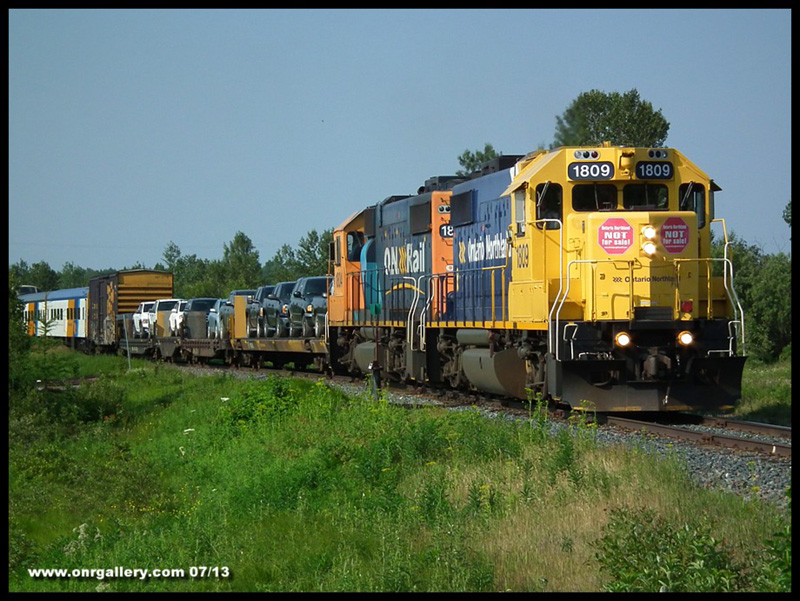
James Lalande reported Quebec-Gatineau (QGRY) 2008 and 1501 have been reassigned to the Huron Central (HCRY). Two others QGRY 800 and 3800 were seem on HCRY train to Sudbury, ON as well in July.
Six Alstom-built CORADIA LINT trainsets arrived in the Port of Montreal from Germany in early June. They departed Coteau, QC under their own power all the way to Ottawa, ON. They are to replace the decade old Bombardier Talent trains, and allow the doubling of O-Train service frequency from 15 minutes to 8 minutes, thanks also to two new passing sidings being constructed this summer. The fate of the other Talent trainsets is uncertain after 2014. There is a possibility to extend quickly to the south to Leitrim Road and Park and Ride using roadbed and track of the old CP Prescott sub, but much is being invested in the new Confederation LRT line and tunnel in the Ottawa core for 2018. The former CP Prince of Wales bridge that connects the Bayview O-Train station to Gatineau has essentially been unused for a decade and the city is unwilling to maintain it. It would allow for extension of O-Train service to the Hull Sector of Gatineau. While the Quebec government is pro-rail especially in the Montreal area, Gatineau only reluctantly allowed the CP rails to be retained during the construction of the parallel STO Rapibus system and seems to prefer buses to rail. (Photos by Ray Ferand)
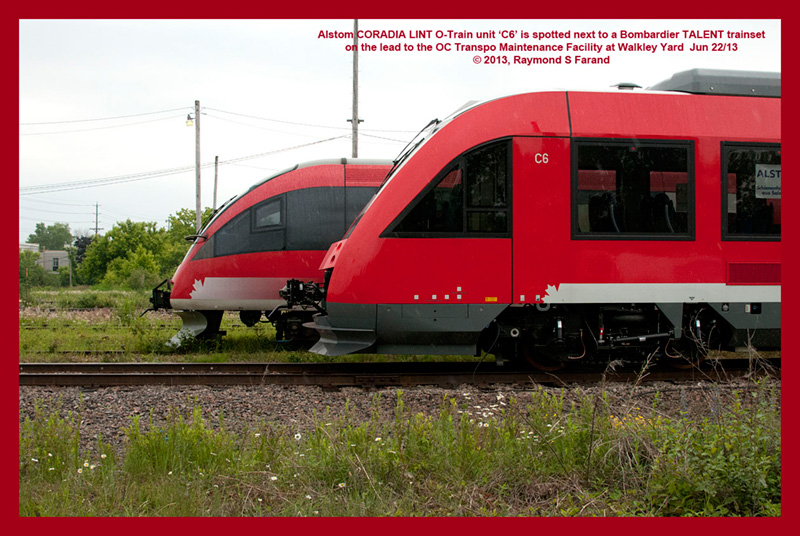
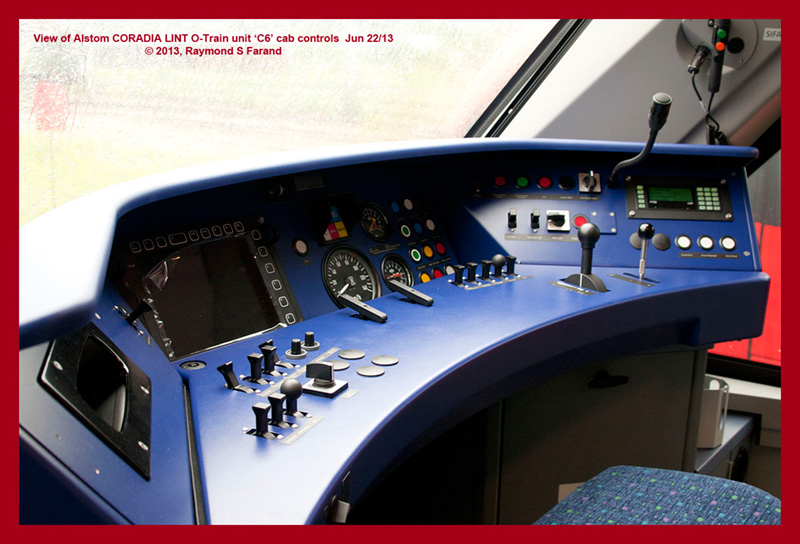
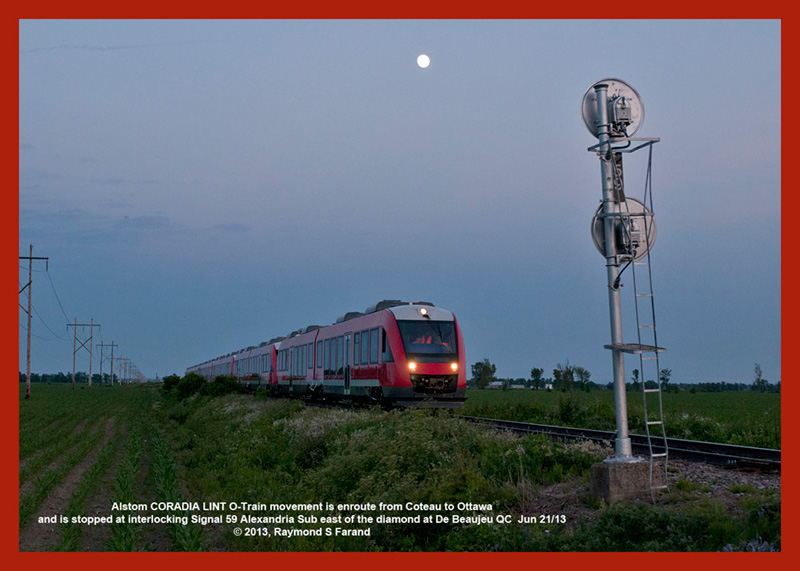
National Steel Car (NSC) in Hamilton, ON, has been contracted to build railway tank cars, and are seeking welders and fabricators for this upcoming production at the plant. The tank car bodies will be built at Trenergy in St Catharines, ON who build boilers and other pressure vessels. The tank car bodies will then be taken down the street in St Catherines to Canadian Erectors where they will be placed onto new railway frames and trucks which they fabricate. The semi finished cars will be then taken by Trilluim Railway (Port Colborne Harbour Railway), for forwarding to National Steel Car (NSC) in Hamilton for finishing and painting. I can confirm Can. Erectors is this week working with Trilluim to revamp and upgrade the track under their large overhead yard crane. This new business production may have Trillium Railway moving between 12-16 cars at a time, and as the entire cars are built locally, this is great economic news for the City of St. Catherines!
In early June, scrappers were cutting up the long stored ex-CN snow plow in Goderich, ON. Later in the month, GEXR GP40 4046 and GP38 3834 had dates with the cutting torch and a crane was used to lift the heavier pieces and remove some components from the generator area in GEXR 4046.
As well, scrappers visited North Bay, ON and cut up Ottawa Valley Railink OVRY SD24 1800, and other unservicable units stored there.
Walter Pfefferle snapped Ontario Southland Railway (OSR) FP9Au 6508 (ex-VIA, nee-CN) in Woodstock, Ontario June 9th, This locomotive has quite a history! CNR 6508 was built by GMD London as an FP9A in November 1954. In June of 1978, it was transferred to VIA, remaining in service until it was rebuilt in June 1984 by CN Pointe St. Charles Shop as a FP9Au, returning to VIA on July 8, 1984 as 6305. Surplus to VIA’s needs, the unit was sold in 1994 to Les Trains Touristque du Saint-Laurent (TTSL) for operation east of Ville de Quebec. When this operation shut down the FP9 along with the TTSL train set was sold privately in May 1997 to be operated by the Waterloo & St. Jacobs Railway. While in WSJR service, 6305 was renumbered back to its original CN road number 6508 and named “Spirit of St. Jacobs”. After the demise of the WSJR operation the train set was stored at VIA’s Toronto Maintenance Centre (TMC) in Mimico until part of the train set, including 6508 was sold to the West Coast Railway Association. By August 2012, the WCRA, electing not to incur further costs of moving equipment west to Squamish, sold 6508 privately for operation on the Ontario Southland Railway.
Ontario Southland Railway found 6508 to be in operable shape internally, and put the unit into service quickly … her first assignment on the former CP St. Thomas Subdivision. Still wearing the colours of then former TTSL/WSJR once an OSR paint scheme is applied, it will be the eighth livery worn by this FP9! (Two in CN service (red, black & grey after 1961) , three for VIA, and one each for TTSL and WSJR. Walter Pfefferle snapped her at Beachville, ON June 8th.
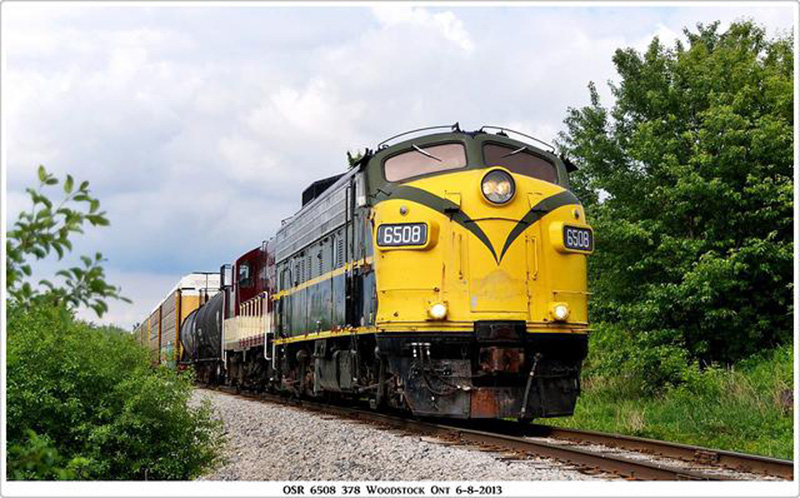
Ontario Southland's GP9 175 is a novelty in and of itself, as the Chesapeake and Ohio 'Chessie System' paint scheme can still be seen all these years later. On December 22nd, OSRX 175 and 383 cruise west through Ingersoll along the CP St. Thomas Sub as light power from Salford, with the usual game plan: lift a handful of hoppers at Putnam - work the yard at Cami, lifting multi's for Woodstock - drop Cami multi's in Woodstock - lift CP multi's dropped at West Coakley and tug them back to Cami.
http://www.railpictures.net/viewphoto.php?id=440089&nseq=84
If you love the look but miss the sound of MLW’s, Walter Pfefferle videoed OSR M420W 644 and OSR RS18u 182 working hard with a long train from Ingersoll to Woodstock.
http://www.youtube.com/watch?v=5aOiX3HixmQ&feature=youtu.be
OSR (Ex-CP) SW1200RS 1249 and 1245 are alive and well on the Ontario Southland Railway. Walter Pfefferle bagged the pair at work July 10th, at Carew in Woodstock ON.
The OSR ran a Business Train with OSR SW1200RS 1245 July 14th, and Walter Pfefferle photographed the special at the station at Woodstock ON.
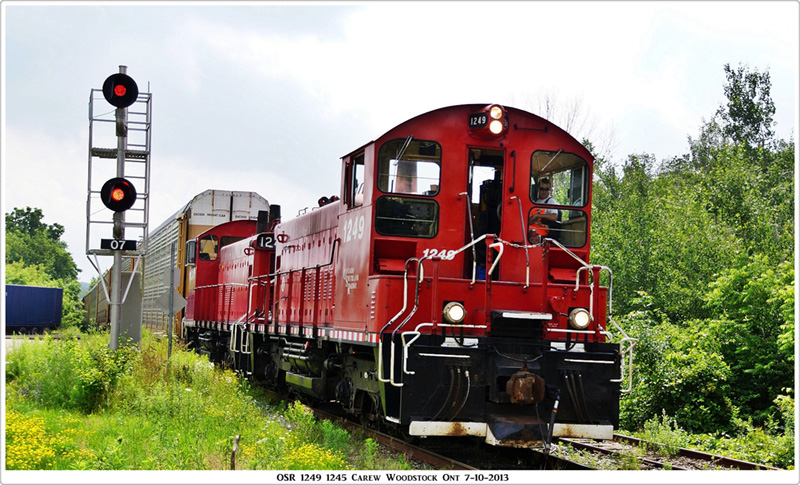
As they took up much needed space at Guelph Junction, OSR owned ex-RLK FP9Au 1400 and 1401 were moved dead in tow to Salford Shop in the first week of July. There are no plans to work on these at present.
Glenn Foster Photo from FACEBOOK [Photo Missing]
Explosions rocked the town of Lac Megantic, QC after a runaway Montreal Maine and Atlantic (MMA) 72 car crude oil train derailed just after midnight on June 6th, Earlier that night, The train had stopped and was supposedly tied down by the one man crew (employee Tom Harding), about 7.6 km’s east of Lac Magantic at Nantes, a designated MM&A crew change point, with a nearby motel. A US two man MM&A crew would later that morning take it across the border. While at the crew change point at Nantes, the lead unit MMA C30-7 5017 caught fire with flames coming from the roof top exhaust stack. The local fire department was called and the small fire was put out, and the loco was then shut down by the fire department. But the off duty Canadian crew member was already at the motel, and (according to his statement was not informed). This small locomotive fire was the catalyst of a terrible chain of events that would send this train to its doom.
As this is on grade, the train began to move down the hill, and just before the derailment was rolling above the posted track speed and heading down the four mile downhill into the town. Witnesses confirmed there were no headlights or horn sounding, and the train appeared to be moving faster than usual. Dozens of buildings were destroyed and many people are missing in the town of 8,000 which is near the Maine border. Hundreds of people were evacuated in the community about 250 kilometres east of Montreal. The locomotives were MMA C30-7 5017, RC van VB-4, MMA C30-7 5026, CITX SD40-2 3053 MMA C30-7 5023, and CEFX SD40-2 3166. This is the first major Crude Oil train derailment in North America. Two weeks after the accident 45 bodies had been recovered with about 10 people still missing. The Canadian TSB in Ottawa claim it could three years to sift through all the evidence. In mid-July, MMA declared bankruptcy.
The horrific scene viewed from a Canadian satellite.
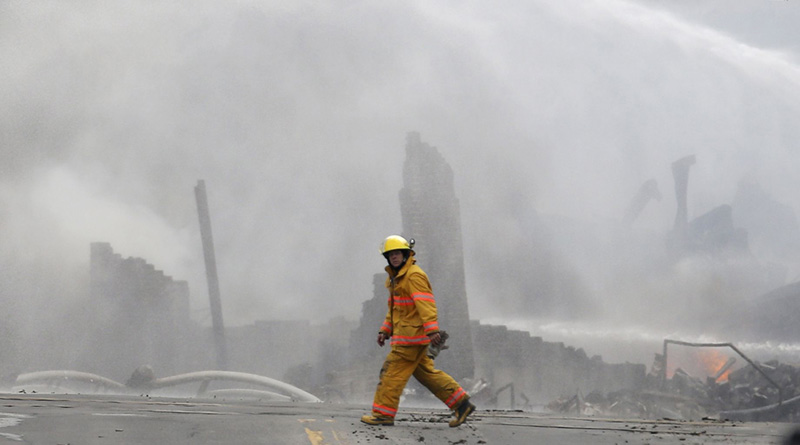
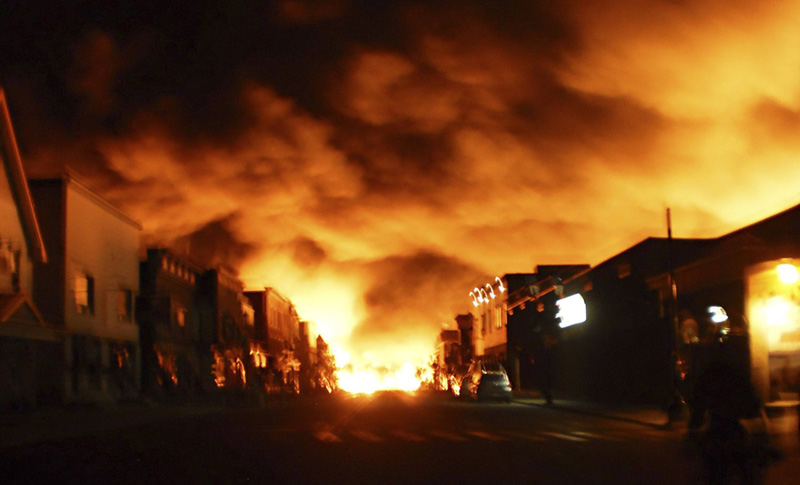
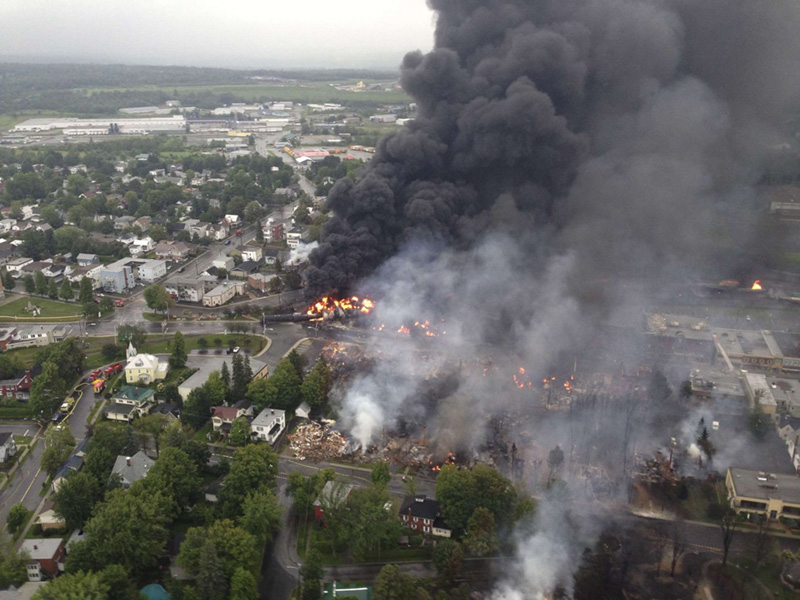
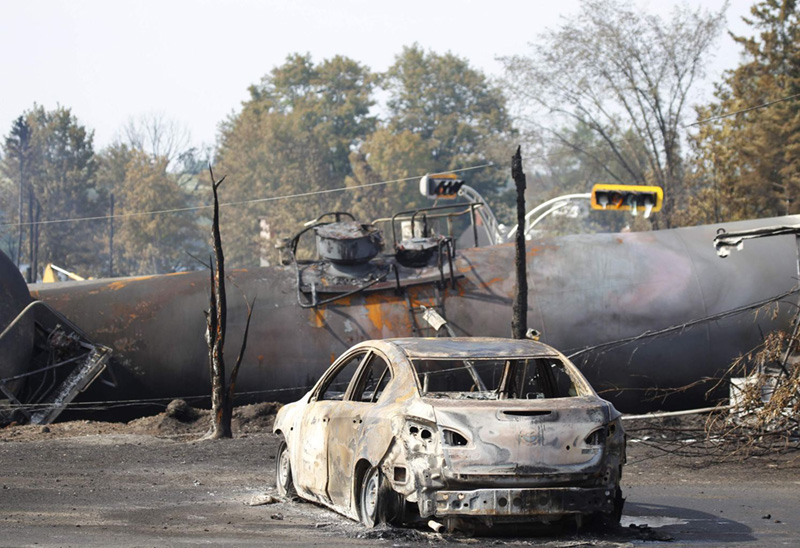
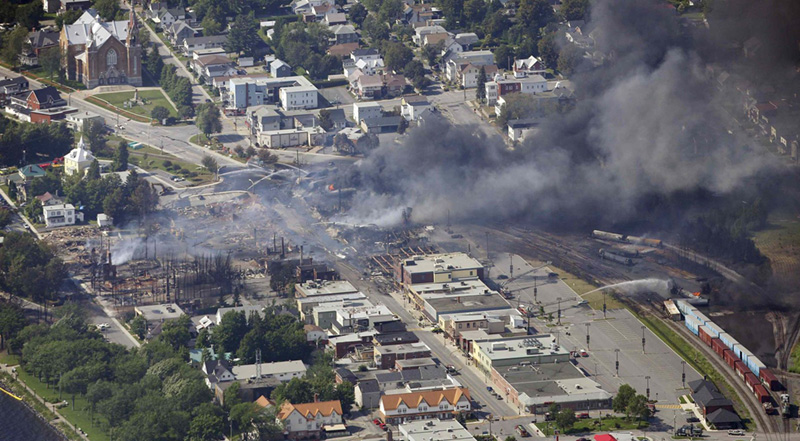
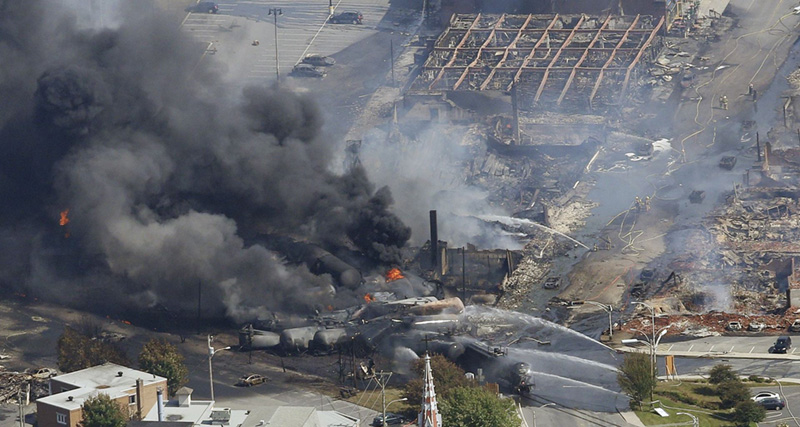
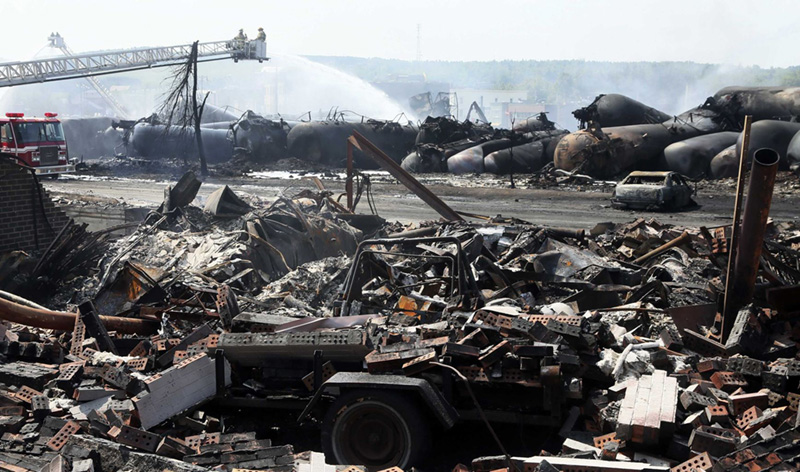
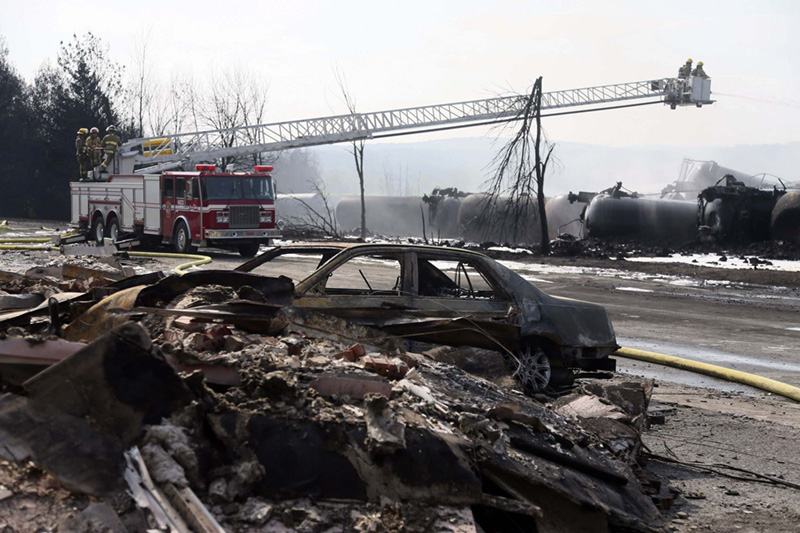
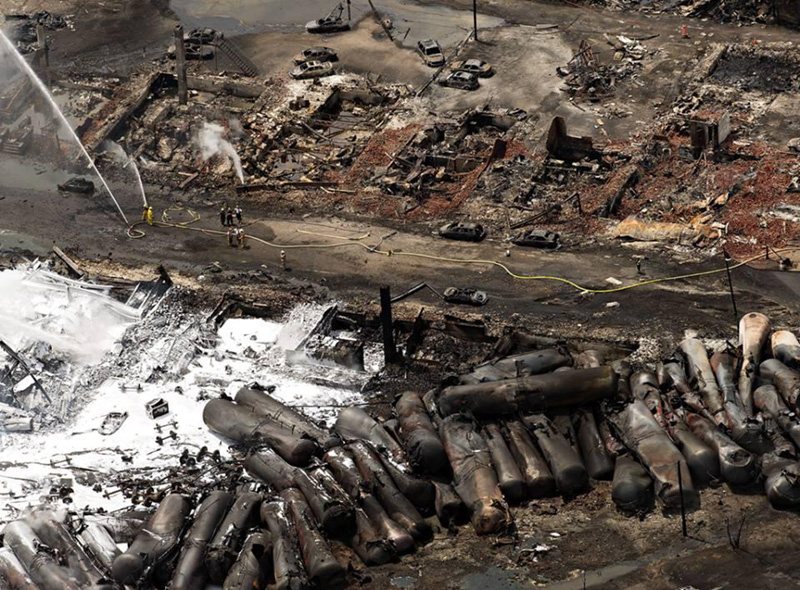
"It's dreadful," said Lac-Megantic resident Claude Bedard. "It's terrible. We've never seen anything like it. The Metro store, Dollarama, everything that was there is gone." Some of the train's 72 cars exploded and a fire that that could be seen for several kilometres spread to a number of homes. "The flames in the sky were really impressive," said resident Pierre Lebeau. A large but undetermined amount of fuel also reportedly spilled into the Chaudière River. Several neighbouring municipalities, including Sherbrooke and Saint-Georges-de-Beauce, were enlisted to help Lac-Megantic deal with the disaster.
The train belongs to Montreal Maine & Atlantic, which owns more than 800 kilometres of track serving Maine, Vermont, Quebec and New Brunswick.
The cause of the derailment will take a year to decipher and questions, discussion and debate followed in the aftermath. First off, with the loco shut down, there would be no air brake application in the lines between the cars holding the train in place. According to the Canadian Rail Operating Rule Book: RULE 112, whether the locomotives are running or not, the cars on the head end of the train are supposed to be tied down with the hand brakes fully applied. The amount of cars that must be tied down can vary somewhat, but the employee is required to test the efficiency of the tie down by trying to push/pull the consist with the locomotives. If the initial parameters are not met and it moves the train, more cars are to be tied down. Whether this was done or not has not come out. The engineer insisted he applied 11 handbrakes but the company did not believe him and he has been laid off without pay. As well, all the engines would have had their handbrakes fully applied.
While the TSB investigation on the Montreal Maine and Atlantic Railway’s disastrous derailment in Lac Megantic will take some time to evaluate, here is a comprehensive study of the rail disaster and the DOT 111A tank car. Interestingly, accident investigators discovered three weeks after the accident The 111A tank cars apparently held up very well, with less than 10% of them losing their crude oil load in spite of the massive wreckage. Therefore it appears they are safe in the dangerous job they have to do! (Please click on the image to enlarge it).
http://wpmedia.news.nationalpost.com/2013/07/na0713_lac-magentic_c-rjweb2400f.jpg
Preliminary TSB report on the MMA derailment at Lac Megantic, QC:
http://www.tsb.gc.ca/eng/enquetes-investigations/rail/2013/R13D0054/R13D0054.asp
Not surprisingly, the MMA runaway oil train is bringing renewed calls on both sides of the U.S.-Canada border for tougher safety rules for railroads. Regulators and watchdogs have sought for years improvements to a common tank car design shown to be susceptible to rupture when derailed, while labor unions have pushed for a ban on trains being operated by a single crew member. Canadian investigators are still probing the cause of what is the nation’s worst rail disaster in more than a century. “Major disasters like this often reveal regulatory failures or highlight gaps in regulatory coverage,” said Katie Greenhaw, regulatory policy analyst at the Center for Effective Government, a Washington-based watchdog. “Other times it shows that there’s lax enforcement of existing regulations.” In Canada, the opposition New Democratic Party is calling for a minimum of two crew members on trains carrying dangerous goods, and a deadline for retiring DOT-111 tank cars, the model that regulators and watchdogs have repeatedly cited and was used on the MM&A train. Party member and Canadian lawmaker Olivia Chow said municipalities should also know when and where dangerous goods are traveling by rail through their towns. Cost Increase Regulations on rail shipments of crude oil are likely to tighten in the wake of the accident, raising operating costs, Moody’s Investor Service said in a July 11 research note. “Canadian and U.S. authorities are likely to increase the regulatory burden on rail shipments of crude and petroleum products, increasing capital and operating costs for rail companies,” according to Moody’s note. “Past rail accidents and catastrophic oil spills have led to strong and costly new regulations.”
CSX Chief Executive Officer Michael Ward today fielded a question from an analyst who asked whether the Quebec accident may lead to more regulation.
CSX Reaction “They’re still investigating what the cause of it is, and I think until the cause is known it’s a little hard to speculate whether there would be additional regulations or not,” Ward said on a conference call after the Jacksonville, Florida-based company reported second-quarter results. “I’m hopeful that as they determine the cause of this, if there’s something to be learned to make us safer, we want to learn from that.” Labor unions in both countries say they plan to redouble efforts to convince regulators to ban one-person train crews. The MM&A train was operated by a single engineer, A second person could ensure procedures are followed in operating and parking trains.
In the U.S., while no regulation or law bans the use of one-person rail crews, regulations dictating what the engineer and conductor do in the locomotive effectively prohibit the practice. Collective bargaining agreements between more than a dozen rail-worker unions and the railroads who employ them have kept two operators in most trains running in the U.S. Sme short-line trains run with a single operator, and larger railroads in collective bargaining have sought support for one-person crews. “Rail safety is not just an employee issue,” said James Stem, national legislative director for the Sheet Metal, Air, Rail and Transportation union’s transportation division, which was formerly the United Transportation Union. “Rail safety impacts every community that railroads go through.”Stem said his union, which represents railroad conductors, and the Brotherhood of Locomotive Engineers and Trainmen, may re-file a petition with the U.S. Federal Railroad Administration asking the agency to require multiple-person operating crews rather than leaving the decision to railroads and unions to work out at the bargaining table. “There’s a certain period of time when the event is still fresh in the mind of the public and action is indeed a possibility,” said Lloyd Burton, a University of Colorado-Denver law and public policy professor who published a 2011 paper on railroad regulation following disaster.
MM&A owner Edward Burkhardt, who has defended the single-operator model as safer because there are fewer distractions, blamed the train’s engineer for failing to properly set the brakes on the parked train. Since the accident, he has said the railroad would no longer leave trains unattended overnight.
Claiming operator error is a common way for companies and regulators to deflect responsibility, Burton said. Blaming the operator shields industries and regulatory agencies from accident investigations that might result in systemic reforms, he said. “Human operator error is typically the first -- and most agencies and firms hope -- the last organizational refuge after an accident,” he wrote in the paper. “The logic is that if the human operator failed in his duties -- to err, after all, is human -- then the system itself must not be broken.” The accident will renew attention on a rule on railcar design that’s languished at the U.S. Pipeline and Hazardous Materials Safety Administration, Burton said. The U.S. National Transportation Safety Board, which can only suggest regulations, has warned that the 30,000 gallon-tank cars are more prone to rupture in crashes than other types of tank cars. The agency recommended thicker shells and other modifications to strengthen the rail cars. If retrofits couldn’t be done, the NTSB suggested phasing out the use of the DOT-111 for transporting hazardous materials. As early as 1994 the Canadian Transport Safety Board cited the equipment as prone to puncture during a derailment. The rail industry has opposed requirements to retrofit cars, saying they could cost as much as $1 billion. The Washington-based Association of American Railroads has supported updated rules for new tank cars and worked with manufacturers on safety improvements.
“We learn from every accident and use this knowledge to continuously improve our safety program,” Kevin F. Thompson, a spokesman for the Federal Railroad Administration, said in an e-mail. “We are closely monitoring the situation in Canada and will continue to learn from the accident as Canadian authorities complete their investigation.” In a July 8 statement, then-transport minister Denis Lebel said he asked the department to “examine any other means of improving rail safety over the coming weeks, months and years.” “We have taken concrete action to increase rail safety. In fact, we have invested over C$100 million ($96.3 million) in rail safety since 2009,” Lebel said in a July 8 press conference. Lebel was replaced July 15 by Conservative lawmaker Lisa Raitt as part of a cabinet-wide shuffle in Canada. The U.S. Senate Commerce Committee is expecting a report this year it requested from the Government Accountability Office reviewing freight rail safety and the agencies that oversee railroads, said Kevin McAlister, a spokesman for the committee.
The disaster may affect the pace of implementing positive train control technology, a centralized electronic communication system that keeps trains from speeding or running into each other. Railroads that operate in the U.S. have a 2015 deadline to install the technology on about 39 percent of track miles. The Association of American Railroads, which represents all the major railroads operating in the U.S., has asked for a delay to the deadline, saying the demand for the equipment will outstrip supply between now and then. “A lot went wrong and a lot of lives have been lost and things are going to change,” said Steven Paget, an analyst based in Calgary with FirstEnergy Capital Corp. “There is going to be increased public attention on rail transportation.” The Association of American Railroads considers it “premature to speculate about how and if this accident could influence future regulations or changes to railroad operating procedures,” said Holly Arthur, a spokeswoman. The group will follow investigators’ findings, she said. “Railroads have long told investors that safety is good business,” Anthony Hatch, an independent analyst based in New York who has tracked railroad companies for almost three decades, said in a telephone interview. “You cannot afford to have derailments on the main line take the main line out of service for any period of time. You’re eating up capacity. If you’re running unsafe, you’re running a very costly railroad.” A disaster points to the need for effective regulation before more people are killed or injured, said Greenhaw, with the Center for Effective Government. “The important thing is to not forget to urge our policymakers to provide these safeguards, sufficiently provide resources for the agencies that need to implement these safeguards so we don’t forget about them until a situation like this happens,” she said. Story by Jon Morgan (Bloomberg)
Later in the month in an interview with the Globe and Mail, Ed Burkhardt, chairman of the Montreal, Maine & Atlantic Railway that operated the ill-fated train, says officials are taking “a huge number of samples of oil” and that investigators “are asking how come there were explosions here. Crude does not blow up.” Earlier this week, Transport Canada sought and received a search warrant to take samples from tank cars not destroyed in a fire that started as a result of the 73-car train rolling uncontrollably into the town and derailing. A Transport Canada spokeswoman said the agency was searching for evidence that the Railway Safety and the Transportation of Dangerous Goods acts were violated. The spokeswoman said violations could lead to criminal prosecutions under existing Canadian law.
The Canadian Railway Safety Act of 1985 allows safety officials access to the cargo. The Transportation of Dangerous Goods Act of 1992 allows officials authorized by the prime minister to inspect property, containers, and goods and to even halt commercial traffic, which an inspector “believes on reasonable grounds” of carrying dangerous goods improperly. “There are questions in the industry as to whether, in fact, the oil is mislabelled when it comes to its qualities,” Burkhardt told the Globe and Mail. “When the Transportation Safety Board issues its report, it is going to be hundreds of pages, and a huge amount of it will be devoted to chemical composition – where this stuff came from and what to do about it.”
Burkhardt said he has been told fluids or chemicals used in the fracking process of extracting oil from the ground might have been present in the crude oil carried by the MM&A train and may explain the explosions and subsequent fire in Lac-Mégantic. Another possible contaminant is hydrogen sulfide, a naturally occurring gas that has been reported in high concentrations in certain Bakken oil field crude oils. Hydrogen sulfide is poisonous, corrosive, and flammable. Published reports say crude oil on the July 6 MM&A train originated in the Bakken oil fields of North Dakota. Canadian investigators are expected to analyze the remaining tank cars' crude oil load to find out if contaminants were present in the oil and if they could have caused the fires resulting from the train’s derailment.
Owned by American Shortline operator Railworld, the Montreal Maine and Atlantic Railroad (MMA) was formed back in 2002, from four former Iron Roads shortlines; Canadian American Railroad (CDAC), Bangor and Aroostook (BAR), Quebec Southern and Vermont Northern. Around 25 trains per day operate over 800 miles of track in Maine, Vermont and Quebec over ex-BAR, and former CP trackage in the Maritimes, and they have trackage rights on CP into Montreal. They interchange with CP, Pan Am Railway, New England Central (NECR), and New Brunswick Southern (NBSR). MMA recently increased their traffic substantially whit a new contract to haul crude oil trains between CP and NBS and they operate a fleet of classic older locomotive models: B30-7, B39-8E, B23-7, SD40-2, GP9, and F40PHR.
The eclectic MMA Roster: (All photos by Ken Goslett and Rick Tilly)
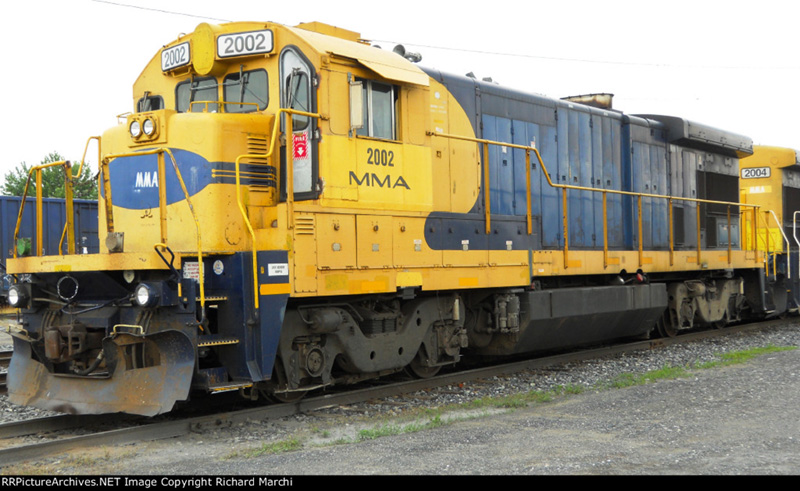 '
'
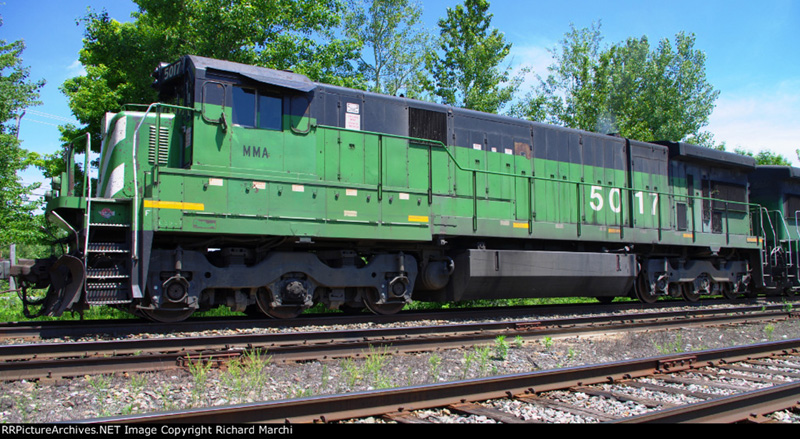
A former LMSX leaser that spent many years on BN, MMA B39-8E 8583 was shot at Millinocket, ME in June 2011. (John Joyce Photo with thanks).
Richard Deuso just submitted several shots of the Montreal Maine & Atlantic (MMA) Crude Oil Train that derailed in Lac Megantic, QC, the morning 6th just after midnight. These photos are of the train consist were shot as it moved eastbound between Brookport, QC and Magog, QC on the afternoon of July 5th. PHOTOS Richard Deuso
On July 23rd, Transport Canada announced an emergency directive pursuant to section 33 of the Railway Safety Act to increase rail safety. Although the cause of the accident in Lac-Mégantic remains unknown at this time, Transport Canada is moving forward to build upon the safety advisories received last Friday from the Transportation Safety Board and further enhance existing safe railway operations and the security of railway transportation. Transport Canada thanks all railway companies for their quick response in implementing this directive following the tragic events in Lac-Mégantic. Effective immediately, the emergency directive requires all rail operators to:
Ensure that no locomotive attached to one or more loaded tank cars transporting dangerous goods is operated with fewer than two qualified persons on a main track or sidings;
Ensure that no locomotive attached to one or more loaded tank cars transporting dangerous goods is left unattended on a main track;
Ensure, within five days of the issuance of the directive, that all unattended controlling locomotives on a main track and sidings are protected from unauthorized entry into the cab;
Ensure the directional controls, commonly known as reversers, are removed from any unattended locomotives, preventing them from moving forward or backward, on a main track or sidings;
Ensure that their company's special instructions on hand brakes are applied to any locomotive attached to one or more cars that is left unattended for more than one hour on a main track or sidings;
Ensure that, in addition to complying with their company's special instructions on hand brakes referred to in the item immediately above, the automatic brake is set in full service position and the independent brake is fully applied for any locomotive attached to one or more cars that are left unattended for one hour or less on a main track or sidings.
The safety of Canadians is Transport Canada's top priority. The department is committed to working with the rail industry to examining any other means of improving rail safety.
Transport Canada has been in contact with the railway industry, and in particular with CN, CP and the Railway Association of Canada (RAC), to work together to promote the continued safety of Canada's rail system.
The majority of railways maintain a culture of safety and security, as shown by the notable decline in derailments and train accidents over the past few years.
Transport Canada inspectors will continue to work in cooperation with the Transportation Safety Board as it conducts its investigation.
Transport Canada inspectors are at Lac-Mégantic determining whether there has been non-compliance with regulatory requirements.
Railway safety regulations exist to ensure the safety and protection of the public. If these regulations were not followed, the department will not hesitate to take action. (Transport Canada)
Apparently some changes have already begun to be implemented regarding transporting dangerous goods by rail. In late July, CP was adding extra buffer cars to their Crude Oil trains on the head end.
Under threatening skies, Francois Jolin photographed the Trois-Rivières- Montreal (CP St Luc) Quebec Gatineau Railway windmill train as it heads west though the St. Lawrence River Valle June 1st. QGRY GP40-2LW 3013 is at the point with 3016 and 2005 trailing on the QGRY Trois-Rivières Sub.
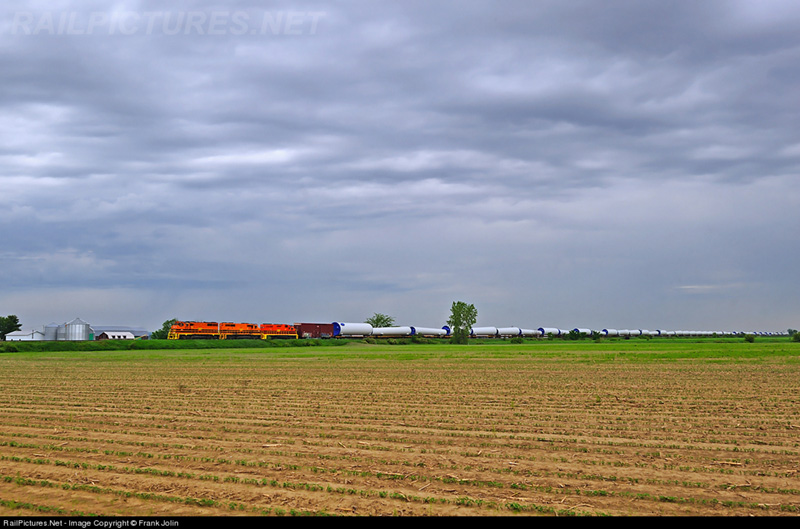
Merci a Daniel Dagenais
Directeur des Opérations / Ops Director
Administration portuaire de Montréal
The Navette Ferroviaire (an operation on the Massif Railway, officially begins in mid-July. A new schedule has been posted.
A new tourist train, called “L’ Amiral”, was launched in July with three special runs this year for the Societe du Chemin de Fer de la Gaspesie. The operation will target a growing cruise ship market in Quebec. On both July 27th and August 15th, the consist will depart New Richmond, MP 68.9 of the former CN Cascapedia Subdivision at 10 a.m. The train will run about an hour east to Bonaventure at MP 89.2. The trip back west will depart Bonaventure at 3:30 p.m. The July trip will be in conjunction with the Bonaventure Western Festival and the August run will be in conjunction with the Acadian National Holiday. September 22nd will find the consist on route for a fall color run departing at 10 a.m. from the peninsula's namesake city of Gaspe at MP 104.2 of the former CN Chandler Subdivision for a 1 hour 15 minute trip west to the town of Perce at MP 65.1. The return trip will depart Perce at 3 p.m., with a targeted arrival back in Gaspe of 4:30 p.m. A road shuttle will connect Perce station with the town, some 6 miles distant.
The L’Amiral train consists of rebuilt former Agence Métropolitaine de Transport (ex-AMT, nee-GO TRANSIT) Hawker Siddley-built commuter coaches trailing former CP RS-18u’s. Hotel power will be provided by a former AMT generator car. In order to generate much needed revenue, two cars have been leased to the Riviére Romaine Railway in Havre St. Pierre for use on the mine's employee shuttle train until full tourist service is up and running. The route is the same one used by VIA Rail Canada's Montreal-Gaspe service, which has not ventured east of New Carlisle since December of 2011. The VIA service was cut short initially due to track conditions, but now due to the state of some of the bridges along the scenic line. Provincial government grants have helped get the tourist service off the ground. Additional provincial funds are being sought to complete repairs to the offending bridges so as to return VIA service back to a region that has depended on the train for transportation for decades. The Admiral's web-site can be found here.
Bernard Babin photographed the official inauguration of the L’Amiral train set on July 27th, 2013. The railway society was inaugurated at the Gaspé Station to celebrate New Richmond's first official start of the L’Amiral tourist train ,along with several dignitaries. "It is an honor to participate in this historic moment for Gaspésie, which has recently acquired a new icon for the tourism industry. The train was just on track we already felt the enthusiasm for the project. I promise you will not be disappointed! "Says the president of the Society of Railway Gaspésie François Roussy, at New Richmond, Quebec. Photo by Bernard Babin.

On June 9th, Train Touristique de Charlevoix (TTC) RS18u 623 is shown at the QGRY / CN interchange in Quebec City destined to the Quebec-Gatineau shop for repairs.
François Gagné Audet PHOTO http://www.railpictures.net/viewphoto.php?id=439520&nseq=16
In June, the Port of Montreal (POM) sold four EMD MP15AC switchers (POM 8303, 8304, 8405, and 8406), to GATX Capital Corporation. They are to be sent to St. Louis, MO, for overhaul, and have been renumbered to
GMTX xxx (ex-POM 8403x)
GMTX 304 (ex-POM 8404),
GMTX 305 (ex-POM 8405)
GMTX xxx (ex-POM 8406)
GMTX MP15DC 304 (ex-Port of Montreal 8403 ) is one of four (GMTX 303 - 306) that are coming to Metro East Industries in East St Louis, IL. In early-July, GMTX 304 and 305 had arrived on MEI property.
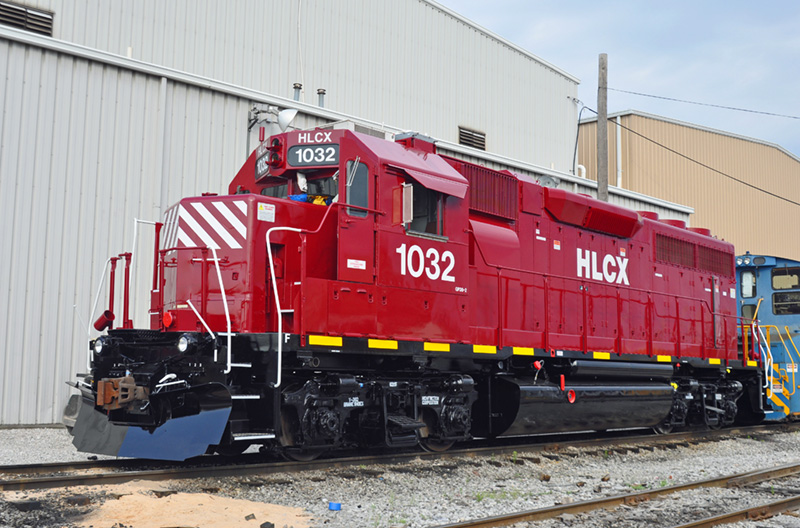
The New England Central (NECR) britge at Alburg, NY was damaged in the sever heat on July 5th bending it out of shape. It is deemed unusable, On July 5th, CN train 324 was detoured over the D&H and this practice continued in July.
Since the big BNSF & CSX six-axle units disappeared after the Mattawamkeag crude oil train wreck on Pan Am Railways February 7th, things on EMR/NBSR have settled down quite a bit. Gone are the big crude oil trains off Pan Am with run-through power. The crude oil trains are being broken up into smaller packets at Waterville, ME and forwarded on regular trains to Mattawamkeag, ME, for onward travel to Irving Oil's St. John, NB refinery on EMRY/NBSR. Now with the Maine, Montreal & Atlantic barely functioning in the wake of the tragic Lac Megantic wreck (July 6th), a lot of traffic has been diverted off MM&A. At least some of it is coming to Mattawamkeag on PAR, judging by the lack of space at Mattwamkeag.
The Bangor (ME) Daily News (BDN) has reported over the last two weeks that MM&A has laid off 79 of its 179 employees in Maine and Quebec. In addition, the BDN is reporting that Maine DOT has approached the other railroads in Maine regarding what their response would be if MM&A were to shut down in the wake of the expected claims in the Lac Megantic tragedy. Specifically, BDN is reporting that ME DOT is looking for a possible operator of MM&A trackage between Boundary, Quebec and Brownville Junction, ME. It is apparently unknown to MM&A management when the accident scene will be released to them for repair. Lac Megantic officials have reportedly asked that the line be rerouted around Lac Megantic.
NBSR/EMR is doing a lot of trackwork during daylight. Heavy June and July rains and flooding have had EMRY/NBSR trains creeping across bridges on the line. An NBSR self-propelled Holmes-type crane is temporarily working out of Danforth distributing a large pile of ties, and an even larger pile of new ties is at Mattawamkeag.
GATX GP38-3 leaser 2639 leads the daily St. John, NB -- Brownville Junction, ME freight out of the woods at Wytopitlock, Maine on a beautiful spring day, May 13, 2013. Although NBSR has repainted several of their HLCX leasers, this has not been the case with the GATX units. They are often in the lead on NBSR westbound trains ahead of six-axle units and are cut off at Mattawamkeag to run west to the Maine Northern Railway connector, bypassing Brownville Junction. These units tie up at Oakfield, ME, in the former Bangor and Aroostook, Maine, Montreal and Atlantic yard.
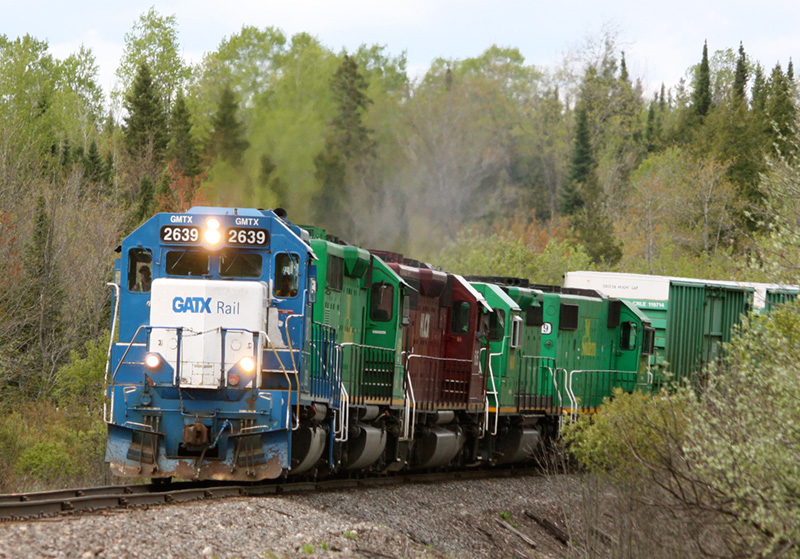
GATX 2644, a GP38-3 leased to New Brunswick Southern, runs around its train in heavy rain at the former Bangor and Aroostook/Maine, Montreal & Atlantic yard at Houlton, ME. This trackage is now owned by the state of Maine, and serviced by New Brunswick Southern Railway's Maine Northern Railway subsidiary. Maine Northern's Houlton local operates out of Oakfield, ME three days a week. This trackage was Bangor and Aroostook's mainline until its abandonment in the mid-1970's. Houlton is now end of track, and home to much of NBSR's track machine maintenance in the former BAR engineering department shop. An abandoned turntable and single stall engine house still remain at Houlton.
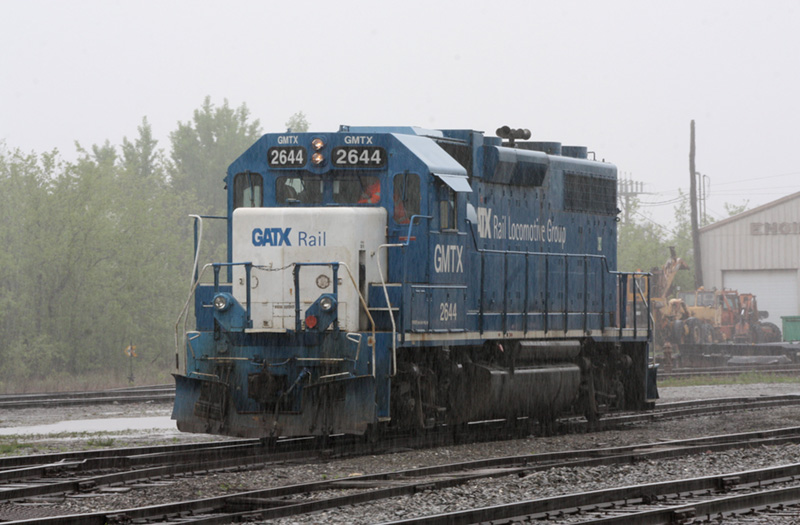
An ex-Conrail SD40, now HLCX SD40-2 6332, leads the daily NBSR/EMRY westbound off the Mattawamkeag River bridge at Bancroft. The pile of old ties is evidence of EMRY's ongoing tie-replacement program. The building to the right is a still-standing Maine Central Railroad track car house.
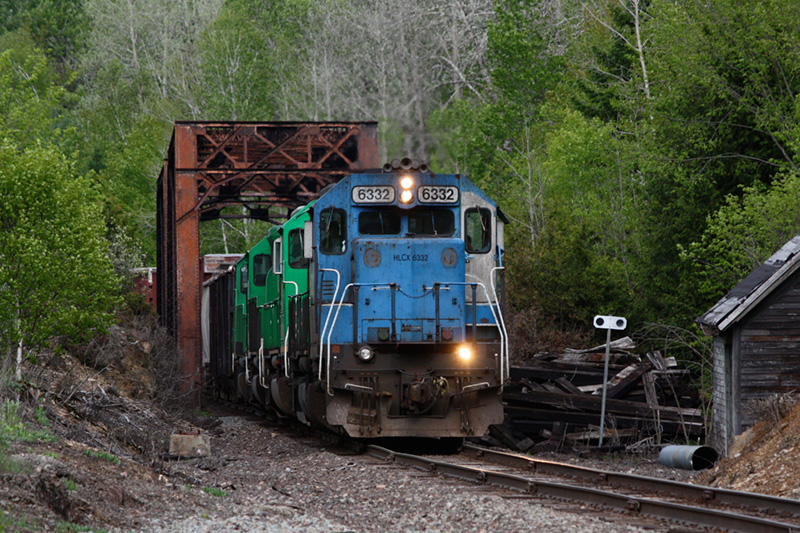
Running long-end forward, NBSR-leased GP38-3 GATX unit GMTX 2639 comes off the Bog Brook Marsh at Bancroft, ME and makes a run for the steep grade up and over Daigles Ridge. It is unusual to see a single unit on EMRY/NBSR, and this eastbound train for McAdam, NB was down to a crawl before the rear passed over the 2000 Road crossing. June 7, 2013.
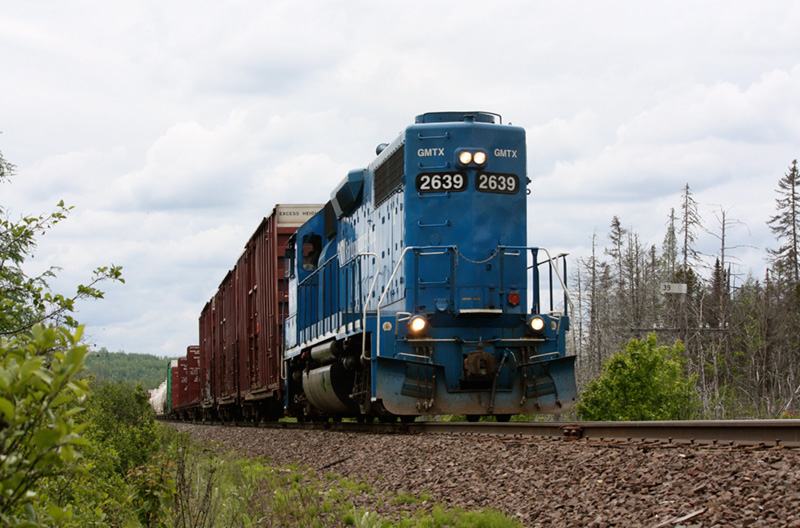
New Brunswick Southern GP38-3 2610 hauls an eastbound local led by a string of pulpwood cars into the former Bangor and Aroostook/Maine, Montreal & Atlantic yard in Houlton, ME on July 12, 2013. The pulp is actually headed for the Lousiana Pacific Mill in New Limerick, ME, west of Houlton, but the unit runs around its train at Houlton after doing local work and drops the cars at New Limerick on the way back to Oakfield, ME.
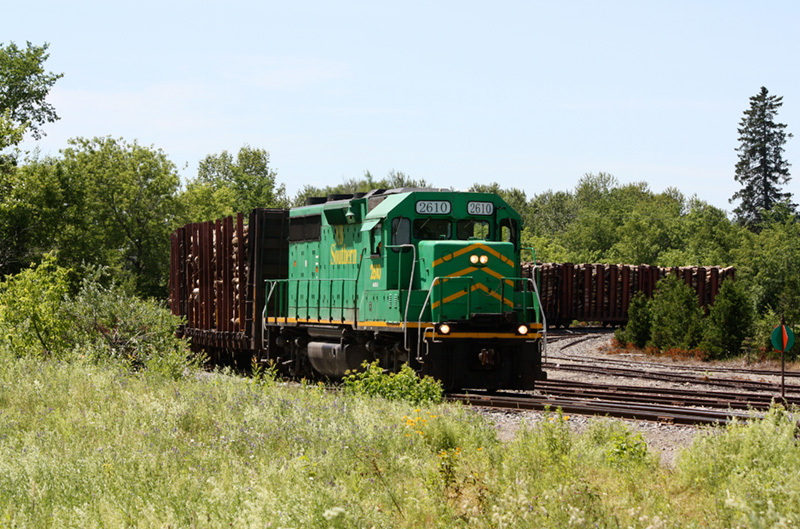
One of three New Brunswick Southern Railway GMTX MP-15 leasers is tied down for the weekend at McAdam, NB yard, along with NBSR GP38-3 2317. NBSR uses the MP15's on it's McAdam, NB to Baileyville, ME road train. A large pulp yard and mill operates at Baileyville. A second NBSR leased MP-15 is usually kept at the mill and switches the yard.
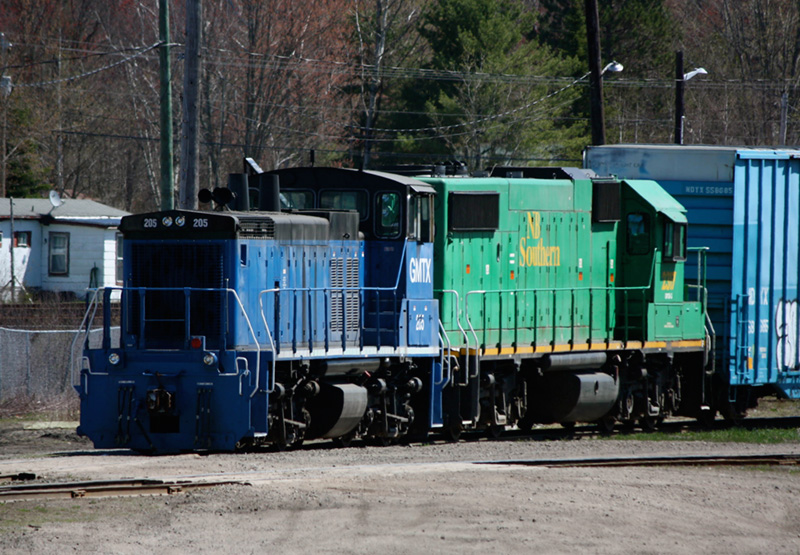
© CRO August 2013
